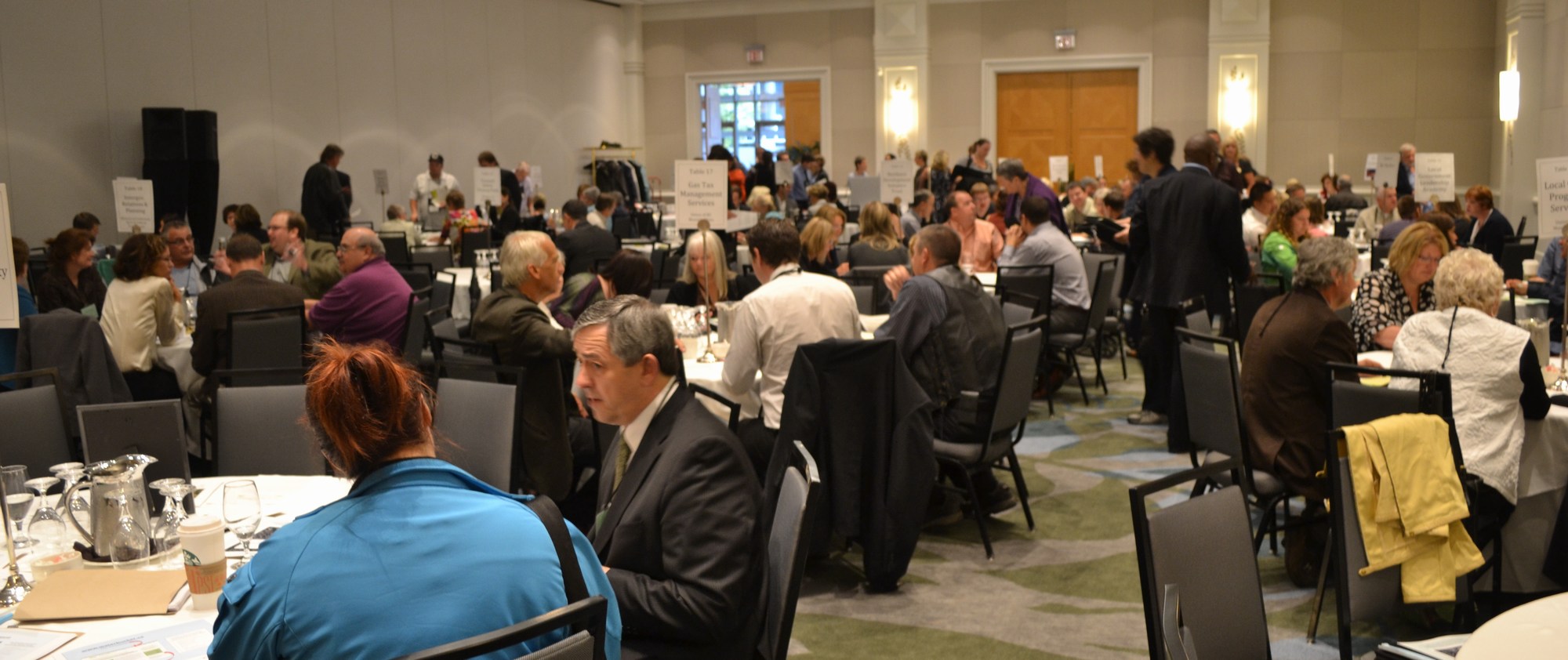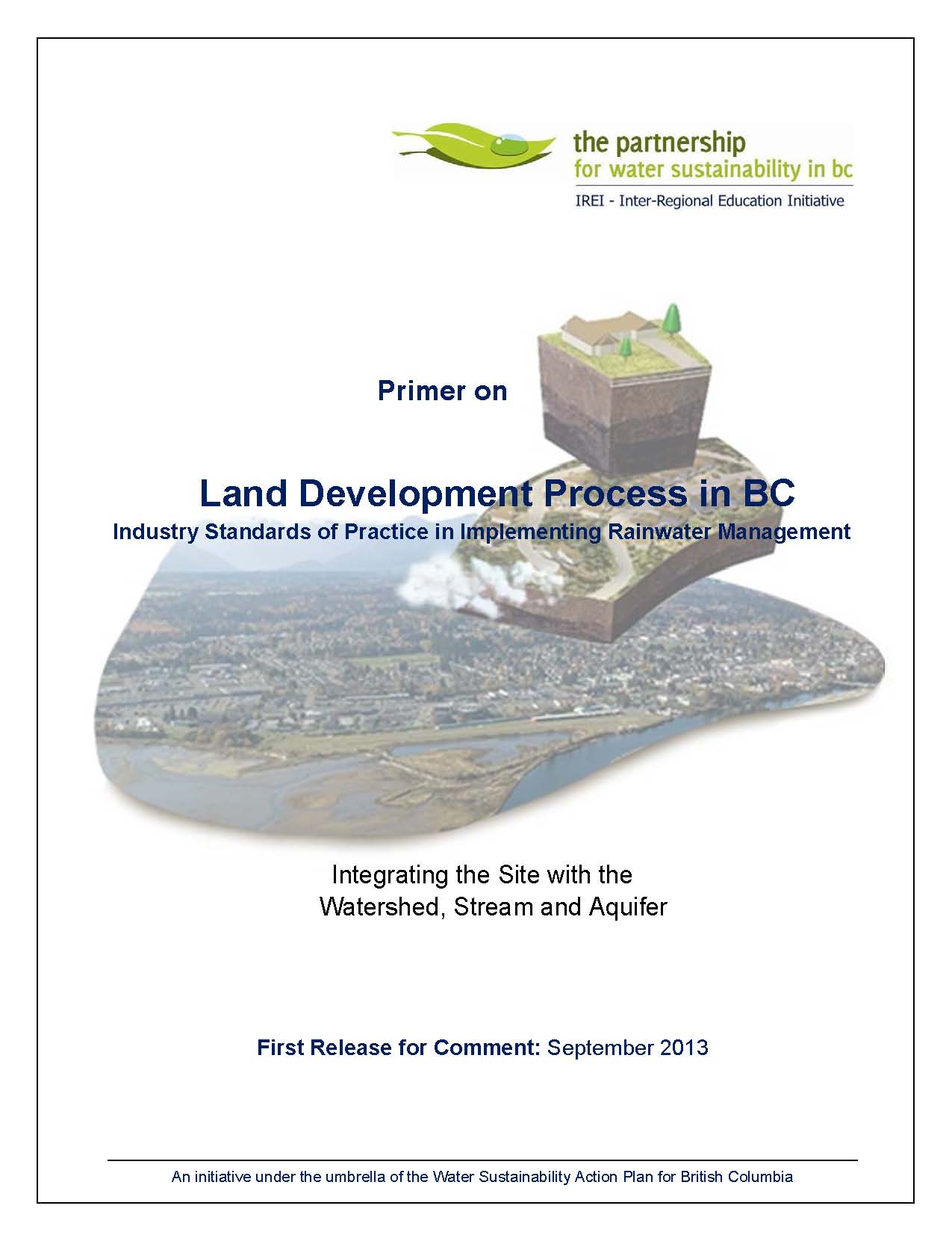Partnership for Water Sustainability released “Primer on Land Development Process in BC” at 2013 UBCM Annual Convention
Note to Reader:
In September 2013, the Union of British Columbia Municipalities (UBCM) offered a half-day session on “Tools, Resources & Funding for Local Governments” as part of the Annual Convention held in downtown Vancouver. The approach to information-sharing built on the precedent established at the 2010 Annual Convention, the first time UBCM organized this type of session for local government elected representatives and senior management.
Twenty provincial and non-government organizations participated. The information-sharing session was a forum for highlighting the tools, resources or other supports these organizations provide in order to help local governments increase capacity and undertake local planning, projects and development. The Partnership for Water Sustainability in BC was part of a contingent that also comprised Asset Management BC and the Ministry of Community, Sport and Cultural Development.
Both the 2010 and 2013 sessions were conducted as a “market place” style event, with representatives of participating organizations seated at tables and local government delegates moving throughout the room.
The UBCM information-sharing session provided the Partnership with a timely and appropriate venue to release the fourth in the Beyond the Guidebook Primer Series. The guidance documents in the series form the basis for knowledge-transfer via the Georgia Basin Inter-Regional Education Initiative (IREI). The foundation document for the series is Stormwater Planning: A Guidebook for British Columbia, released in 2002.
To download a copy of the fourth in the Beyond the Guidebook Primer Series, click on Primer on Land Development Process in BC: Industry Standards of Practice in Implementing Rainwater Management.
Administrative Framework for Implementing Rainwater Management: Bridging the Gap between Awareness and Capability
Core concepts presented in the Beyond the Guidebook Primer Series provide an educational foundation for rainwater management in a watershed context. The Partnership’s purpose in developing the Primers is to inform and educate infrastructure, land use and environmental professionals about implementing actions at the site scale that will achieve desired outcomes at the watershed scale.
The focus of the Primer on the Land Development Process in BC is the disconnect between the Land Subdivision and Building Construction steps, and the challenges this creates for implementation of rainwater management. The Primer fills a gap by addressing the administrative part of the process.
The Goal: Mimic the Natural Water Balance
“Protection of watershed and stream health ultimately involves maintaining the natural proportion of rainwater entering streams via three pathways: surface flow, interflow, and groundwater flow. This desired outcome is described as ‘mimicking the natural Water Balance’,” states Kim Stephens, Executive Director of the Partnership for Water Sustainability in BC. He was Project Manager and principal author of BC’s Guidebook.
 “Provincial direction is to mimic the natural Water Balance to protect stream and watershed health. In 2002, looking at rainfall differently led the Province of British Columbia to adopt the Water Balance Methodology, initiate a performance target approach to capturing rain where it falls, and initiate changes in the ways rainwater runoff is returned to streams.”
“Provincial direction is to mimic the natural Water Balance to protect stream and watershed health. In 2002, looking at rainfall differently led the Province of British Columbia to adopt the Water Balance Methodology, initiate a performance target approach to capturing rain where it falls, and initiate changes in the ways rainwater runoff is returned to streams.”
 “Mimicking the natural Water Balance following land development depends on a clear delineation and common understanding of expectations, roles and responsibilities of those involved in the Land Development Process. This requires a seamless progression from Rezoning through to Land Subdivision and Building Construction,” adds Tim Pringle, Partnership President.
“Mimicking the natural Water Balance following land development depends on a clear delineation and common understanding of expectations, roles and responsibilities of those involved in the Land Development Process. This requires a seamless progression from Rezoning through to Land Subdivision and Building Construction,” adds Tim Pringle, Partnership President.
“The UBCM venue provided us with an opportunity to have conversations with many local government representatives about their need to do business differently. We explained that the Primer on Land Development Process in BC is a ‘bridging document’ because it illustrates how local governments can seamlessly integrate the legal and administrative parts of the Land Development Process through the designing with nature and rainwater management lens.”
Land Development Process in BC: Distinct and Separate Steps
“The Land Development Process is comprised of a series of distinct and separate steps. The people and their roles change significantly as the process moves from the first step of land use rezoning through the creation of the subdivision and finally to constructing the dwellings on individual sites for occupation and use,” explains Jim Dumont, principalauthor of the Primer and the Partnership’s Engineering Applications Authority.
 “It is the change of the roles and responsibilities that occurs during the process of land development that needs to be understood in order to implement rainwater management systems that successfully mimic the natural Water Balance.”
“It is the change of the roles and responsibilities that occurs during the process of land development that needs to be understood in order to implement rainwater management systems that successfully mimic the natural Water Balance.”
“A new set of processes is required to allow successful implementation. This need is the focus of this Primer.”
Implementing Rainwater Management: Administrative Process Requirements
“While much attention is given to the technical and legal aspects of rainwater management, we are not aware of anyone who has addressed administration. At the heart of the Primer, then, is the discussion at the end of Section 6 about Administrative Process Requirements. This piece of the puzzle is the key to implementation of effective rainwater management systems on private property,” continues Tim Pringle.
“Section 6 provides comprehensive guidance on how to achieve a balance of enforceable regulation that, through Bylaws and an Administrative Process, results in a bridge from Land Subdivision to Building Construction,” explains Jim Dumont.
“Section 6 introduces three approaches to infrastructure implementation: Within Public Rights-Of-Way; On Private Property; and Distributed.”
“Section 6 then elaborates on the Distributed option on the basis that it is the most likely to be adopted by a typical local government. By definition, Distributed means that rainwater management infrastructure would be located on both public and private lands.”
“Section 6 is the heart of the Primer content because the discussion of Administrative Process Requirements delves into the ‘how-to-do-it’ details of changes that will enable local governments, developers and design professionals to move from awareness to action more easily,” concludes Jim Dumont.
To Learn More:
To download a copy, click on Primer on Land Development Process in BC: Industry Standards of Practice in Implementing Rainwater Management.
For a section-by-section synopsis of the Primer storyline, click on the following link to Table 1. Sections 1 and 2 establish the regulatory context and describe the Primer scope, respectively. To achieve the educational objectives, the balance of the Primer is organized in five sections: Sections 3 and 4 provide context; Sections 5 and 6 provide guidance; and Section 7 consolidates what is important to know.



